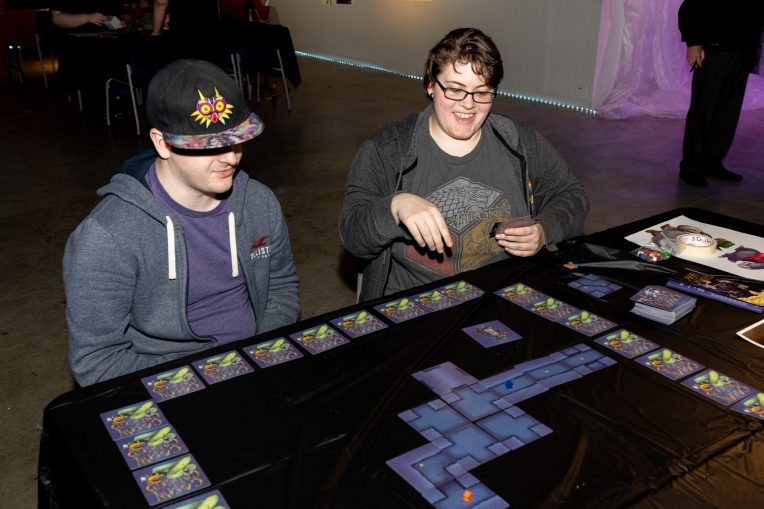A chorus of 8-bit arcade music, rolling dice, shuffling cards—and laughter—reverberated throughout the first-ever Games Showcase, hosted by Illinois State University’s Creative Technologies (CTK) program Friday, May 6, in the Center for the Visual Arts.
A steady stream of visitors throughout the four-hour event were invited to play more than 25 board, card, mobile, and video games all created by Illinois State students, many of whom are enrolled in CTK’s game design sequence, while others are studying in programs such as information technology or are involved in gaming registered student organizations.
“To see what students have developed and learned is really cool,” said Levi Arnett, a senior who is among the first seven graduates of CTK’s game design sequence. He and his six fellow-seniors collaborated on a yearlong capstone project to create two professional-quality games—one analogue and one digital.
The capstone board game, Cavern Crawlers, is a fast-paced tile-placement game in which critters race in caverns to find, collect, and, eventually, steal treasures to win. “It gets really competitive,” said Lys Shilling, another CTK game design sequence senior who served as art lead for the capstone project. “It’s a path-building, competitive adventure game, and there’s a lot of strategy especially in mid- to late-game.”

The capstone digital game, Geriatric Jamboree, is a humorous, 2D fighting game with an 8-bit soundtrack set at the Shady Acres retirement home. Elderly heroes fight with yarn balls, muffin guns, and dentures, among other comical weapons. “It’s a fun, lighthearted game in the same vein as Super Smash Bros.,” Arnett said. “There’s a lot of movement involved, and each character is unique.”
Arnett, Shilling, and their classmates began conceptualizing both games at the beginning of the fall semester with guidance from Dr. Sercan Şengün, assistant professor of Creative Technologies and lead organizer of the Games Showcase event. From ideation, to prototyping, to playtesting, to completion, Şengün said he formatted the capstone class to mirror a professional project.
“When students go into industry, they will be working with all kinds of creative and interesting people,” Şengün said. “They have to learn how to communicate, they have to learn how to form groups, and they’ll have to complete projects from beginning to end.”

While some students worked on video game coding using the computer program Unity, others worked on developing rules, storylines, and characters. Shilling’s art concepts began as simple sketches in the fall before evolving into detailed, finished work ahead of the Games Showcase.
“I love seeing my art come to life,” Shilling said. “I love drawing something, and it actually being actively used and interacted with. I think it’s a really neat experience. I may have gotten emotional. I feel so much pride over this.”
Şengün said it was also important for students to consider diversity and representation as they designed their games. As a result of the pandemic and more time spent at home, he said more people from different demographics are playing games now than ever before.
“The idea for the capstone digital game came from a conversation we had about who isn’t represented much in games,” Şengün said. “The students said, ‘We don’t see a lot of elderly people in games,’ and they decided to have a humorous game where the characters are elderly superheroes.”
Şengün said Geriatric Jamboree will eventually be available for public download and Cavern Crawlers will be available to purchase.

“It is very exciting today because in the creative process, you actually don’t see the outcome until the final days,” Şengün said. “In the last few weeks, things magically came together. I am very happy with both games. I am really proud of the students. They really worked hard, and this is a preview to the campus community.”
While this year’s inaugural CTK game design sequence capstone consisted of seven students, next year’s senior class will include around 30 students. Arnett said he expects the quality of games and level of creativity to increase as the program grows.
Ian (Kaelin) Cooper is a printmaking graduate student who collaborated with CTK to create Occentatia, a digital game they have been conceptualizing for the past four years. The game’s current iteration was on display at the Games Showcase.
Cooper said Occentatia merges queer theory and safe spaces and allows participants to experience escapism and healing through an action-adventure lens while they’re immersed in the game’s celestial oasis.
“It started out as an individual passion project,” Cooper said. “Then I started working on it more this semester because a lot of my instructors and peers were saying, ‘This makes sense with a lot of the other visual imagery that you’re presenting. So, let’s go ahead and really start working on this. Don’t keep hiding this.’”
During the Games Showcase, participants could experience Occentatia’s setting both through a virtual reality experience and a physical display featuring pastel lighting, Grecian columns, and character cards on pedestals. Cooper has been working with a team of five to six people to make their vision for the game a reality.

“I think the most rewarding part of this experience is just being able to listen to people and hear how they want to contribute and that they believe in the same charismatic, embrace of energy that I feel for the project,” Cooper said. “That’s always really warming to me. It opens up a whole new world when I let myself share this idea and let others start to enjoy it and expand upon it.”
Cooper said they felt inspired to see their project alongside many other impressive creations, and they planned to network with other designers and potentially seek collaborative opportunities.
As visitors to the Games Showcase moved from table to table exploring the diverse and creative offerings, Arnett said he believes that games play an important role in society. “There’s a lot of negative stuff in the world,” Arnett said. “But games are a super accessible way to have fun.”

